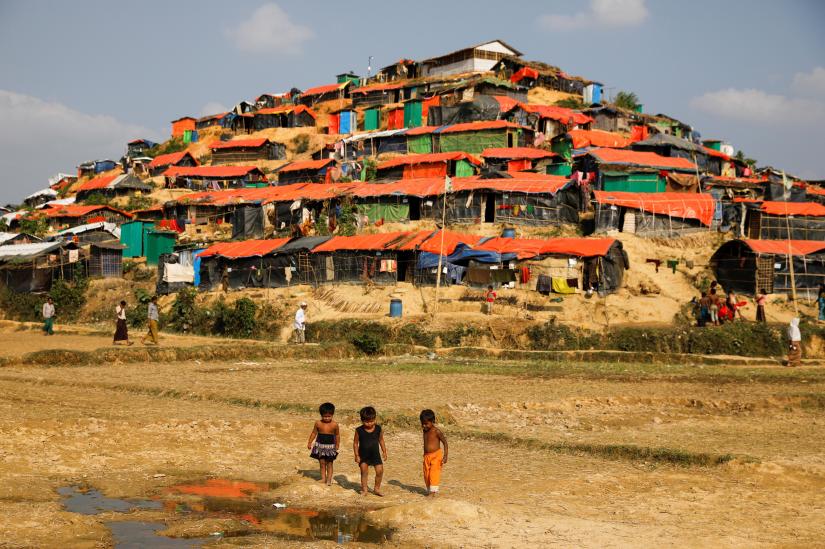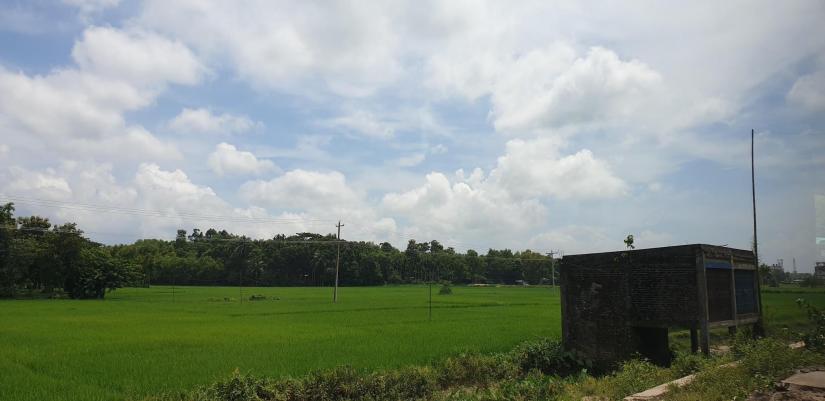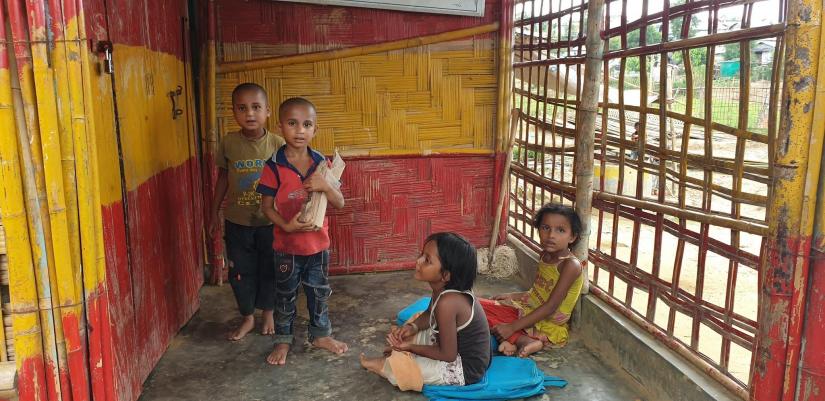A spot report from the camps of the Rohingya refugees in Kutupalong, Bangladesh. At 11am the road from Ukhia to Kutupalong is congested. Ukhia is 36 kilometers away from Cox’s Bazar, the longest sea beach in the world and Bangladesh’s top tourist spot. On the road towards the camps trucks filled with goods, engine operated tom-toms, buses, autorickshaws, private cars, and other vehicles fill the way. Our annoyed driver remarks that Dhaka highway is not this bad with the construction work. When asked about what is causing the traffic jam, he said relief goods and people are going to the camps.
At 11am the road from Ukhia to Kutupalong is congested. Ukhia is 36 kilometers away from Cox’s Bazar, the longest sea beach in the world and Bangladesh’s top tourist spot. On the road towards the camps trucks filled with goods, engine operated tom-toms, buses, autorickshaws, private cars, and other vehicles fill the way. Our annoyed driver remarks that Dhaka highway is not this bad with the construction work. When asked about what is causing the traffic jam, he said relief goods and people are going to the camps.
Incomplete buildings and To-Let signs
On the road from Cox's Bazar and before reaching Ukhia, there are many new buildings on both sides of the road. Each of them has a To-Let sign hanging on them: Office and Flat for rent. Many of the incomplete buildings already house NGO offices and homes for their employees. Also, two and three storied buildings are being made with the same goal. They have already figured out that these NGOs will be staying for a long time. Therefore it is profitable to construct buildings. There is also a bustling North End on one side of the road. A journalist and NGO employee remarked how the business for North End is good.
Nature on both sides The road from Kutupalong to Ukhia will capture the eyes of any passerby. The rice fields are no less green than the jungles and forests surrounding it. The hills of Bangladesh are like no other in the world. There are signs of "beware of wild elephants," the animals still roam the area. However, because of the increasing human population, elephants avoid coming out. Cutting away green forests and rice fields like this, the Rohingya camps in Kutupalong have an area of 6 .5 lakh acres. In those places, there are only camps filled with tents, mud huts and tin sheds. The camp areas were not only government property but also privately owned by many local people. Many locals have lost their property; they thought that the Rohingya would temporarily use their lands and then go back to Myanmar. The ownership of the area is now complicated and worrisome for the locals. With each passing day, locals are losing hope, whether they will get their land back.
The road from Kutupalong to Ukhia will capture the eyes of any passerby. The rice fields are no less green than the jungles and forests surrounding it. The hills of Bangladesh are like no other in the world. There are signs of "beware of wild elephants," the animals still roam the area. However, because of the increasing human population, elephants avoid coming out. Cutting away green forests and rice fields like this, the Rohingya camps in Kutupalong have an area of 6 .5 lakh acres. In those places, there are only camps filled with tents, mud huts and tin sheds. The camp areas were not only government property but also privately owned by many local people. Many locals have lost their property; they thought that the Rohingya would temporarily use their lands and then go back to Myanmar. The ownership of the area is now complicated and worrisome for the locals. With each passing day, locals are losing hope, whether they will get their land back.
Permanent bazar in front of the camps
Upon entering the camps, one cannot say if it is a refugee camp. It looks more like a town's bazaar with shops selling clothes, shoes, and grocery shops, and even shops selling and buying gold. The bazaar seeps into the camps. Many Rohingya women in Burka have come to shop in the bazaar. What little can be seen from the unconvinced face is touched with Burmese style makeup. Just seeing them, one would remark they are not refugees but rather middle-class women. A bit more into the bazaar, a man is making blue steel trunks. His name is Aflaton. His father was in the same business and now seeing the growing need for such items, he found the Rohingya camps a profitable place. Talking to an NGO worker, we found out that in 1978 and 1992, the Rohingya, who came here, are still residing in these camps. Why they are in charge of many of these camps, they couldn't reply. A local journalist believes that the NGOs are employing people by the Bangladesh National Party (BNP) and Jamaat-E-Islami (JMB).
Natural Immigration Through the main bazaar into the camps, there are shops and restaurants on both sides of the road. In one of these restaurants, two patrons are eating parched-rice (muri) and fried-chickpeas (Chola) with the help of spoons. One of them is AbulKasem, and the other is Abdullah. Looking closely at Abdullah, you can guess he is not from the Rohingya community but is purely Burmese. A round face, small nose, and a shade of light brown skin. He says that he came to Bangladesh in 2007 and converted to Islam after coming here. He was a Burmese Buddist and before, he was called Play Ong Sae. He came here in search of work. After converting to Islam, he cannot return to his relatives. After talking to him, we come to know that many come to Bangladesh in search of work and livelihood. Therefore, like most border places and emerging markets, there is natural immigration in these areas.
Through the main bazaar into the camps, there are shops and restaurants on both sides of the road. In one of these restaurants, two patrons are eating parched-rice (muri) and fried-chickpeas (Chola) with the help of spoons. One of them is AbulKasem, and the other is Abdullah. Looking closely at Abdullah, you can guess he is not from the Rohingya community but is purely Burmese. A round face, small nose, and a shade of light brown skin. He says that he came to Bangladesh in 2007 and converted to Islam after coming here. He was a Burmese Buddist and before, he was called Play Ong Sae. He came here in search of work. After converting to Islam, he cannot return to his relatives. After talking to him, we come to know that many come to Bangladesh in search of work and livelihood. Therefore, like most border places and emerging markets, there is natural immigration in these areas.
Medicine and child health
In most refugee camps, the medicine that is available in the shops tends to be for saving lives. The pharmacies in these camps show a different ordeal. The prescription here is to elongate life and herbal medicine. By walking only 50 yards, it's evident that emergency or life-saving medicine is not required. In these 50 yards, there were almost 49 children with ages ranging from 5 to 8 years. And there were about two whose ages were less than 2, which means they were born in Bangladesh. The children/infants with ages around 2 are very healthy. Even in the slums of Dhaka, finding healthy children like this is impossible. Only one of the children had a bit of scurvy.
Tube oil and Supply Water From experience in the refugee camps, there are two things that make life difficult for a refugee, one is clean water, and the other is lack of food. For the Rohingya, there is no such problem. By looking at the kids, it's clear that they don't lack any of the necessities. There are systems of tube wells and water supply in the areas, designated garbage spots mean that there are people to remove waste as well. Also, worms seem not to be a problem as all of the people are wearing sandals.
From experience in the refugee camps, there are two things that make life difficult for a refugee, one is clean water, and the other is lack of food. For the Rohingya, there is no such problem. By looking at the kids, it's clear that they don't lack any of the necessities. There are systems of tube wells and water supply in the areas, designated garbage spots mean that there are people to remove waste as well. Also, worms seem not to be a problem as all of the people are wearing sandals.
Mobile repair shops and songs blasted from cell phone speakers
After the Rohingya rally on 25th August, the mobile network was cut from the area. But that doesn't seem to be the case in the camps of Kutupalong. Most of the Rohingya are talking on their phones. And from further sources, we got to know that local NGOs, old Rohingya refugees, and BNP-Jamaat people helped them acquire sim cards. Some of them are still using Myanmar's network. A teenager wearing jeans and a T-shirt listens to songs with his headphones as he dangles his feet on a bench. A little further was a mobile repair shop. The business is good for the owner. The owner says that 10 percent of people use the touch screen while the other 90-percent use button-based mobiles. But looking at the phones on the shop's shelves, there were about 96 button-based mobiles and 16 touch screen ones. In that case, 17-18 percent of cell phones are a touch screen.
How are you? Are you well (Kemon Achen? Bhalo Achen?)  Rahim and Rohan are between four and a half to five years old. They are wearing yellow T-Shirts and jeans. Seeing us, a group of children said, "Kemon Achen? BhaloAchen?" Asking them if they were well "BhaloAchen," their faces lit up with happiness. The reason is that they were able to learn Bangla. They are speaking in Bangla. When asking them what they ate in the morning, they replied they ate the school's breakfast. They are educated in a learning center. Here kids are taught as well as given breakfast and lunch. After talking with an instructor, they said it was being run by UNHCR, MUKTI (which the government deemed as banned), and Plan International. With the help of this learning center, 350 kids like Rahim and Rohan are learning Bangla. A little after the learning center is Plan International's office. In their office walls, lines in English and Burmese occupy the boards on the walls. After talking to them, they deny teaching students Bangla. But an NGO employee in Ukiah says that they are not only teaching them Bangla but also the dialect of Chattogram.
Rahim and Rohan are between four and a half to five years old. They are wearing yellow T-Shirts and jeans. Seeing us, a group of children said, "Kemon Achen? BhaloAchen?" Asking them if they were well "BhaloAchen," their faces lit up with happiness. The reason is that they were able to learn Bangla. They are speaking in Bangla. When asking them what they ate in the morning, they replied they ate the school's breakfast. They are educated in a learning center. Here kids are taught as well as given breakfast and lunch. After talking with an instructor, they said it was being run by UNHCR, MUKTI (which the government deemed as banned), and Plan International. With the help of this learning center, 350 kids like Rahim and Rohan are learning Bangla. A little after the learning center is Plan International's office. In their office walls, lines in English and Burmese occupy the boards on the walls. After talking to them, they deny teaching students Bangla. But an NGO employee in Ukiah says that they are not only teaching them Bangla but also the dialect of Chattogram.
Chicken Farms
A little further from the Bangla learning centers are three chicken farms on the roadside. With the help of the NGO's, the Rohingya have started these chicken farms. A local NGO employee tells that the NGOs are not only helping the refugees with chicken farms but also other businesses. He says that Rohingya men operate six to seven thousand Tom Toms and CNG vehicles. The NGO employee remarks that the primary goal of the refugees is to become Bangladeshi citizens. And the local NGO is helping them gradually to do that. When asked whether the government banned 40 NGOs. He replied that "Didn't you see that Mukti is still in operation" And those who are afraid to work directly, merge with others such as Muslim Aid and Al Major and then operate.
Jobs for the Rohingya as well as businesses
Refugees do not have the option to work in a foreign country, and there is a law in Bangladesh which states this. Still, former Administrator Abdul Kalamtaking advice from the NGOs has helped them to get jobs, said a local journalist. The NGO's figured out that refugees cannot work long term but could work daily and have been engaged in positions like that. An NGO worker and development worker said that many of the volunteers and NGO workers are also from the Rohingya community. The general idea is that Rohingya tend to be illiterate. Like most underprivileged communities of a country, the Rohingya are uneducated but saying that all Rohingya are ignorant would be wrong. There are many skilled workers in their community. And near the Masjids where the Rohingya refugees go for namaz in their Punjabi, it's easy to say that they are living well supplied with. The Development employee remarked that many Rohingyamen are educated but the girls remain uneducated. One of their strong points is that they know proper English. Whenever there are diplomats or foreigners, the Rohingyas speak on their behalf. He said when the US and Chinese Ambassador came, it was the educated among them who spoke. The working Rohingya earns from eighteen thousand to one lac taka, even though their wages are shown to be on an hourly or daily basis.
Refugees receiving foreign remittance
Like the Bangladeshis' the Rohingya youth have been working in many of the middle eastern countries. They are sending back the money to the camps. The local NGOs and old-resident Rohingyas are also helping them to channel in cash. But the money is not put in banks; the refugees keep it in other ways. The locals say that they are saving the money in polythene bags under their house. Comparing the situation of the 1971 refugee crisis, it is clear the Bangladeshi government is creating a paradise for the refugees. There is no chance of water seeping into their floors as well; there are cement blocks around their houses. And compared to the refugees of 1971, they are getting more help. Much of which goes to waste. Most of the things they receive are sold off, and their illegal business/informal economy grows
"Majhis" involved in corruption
A development employee who asked to remain anonymous said that the government made a mistake when it gave power to "Mahjis" to control the Rohingya camps. The Majhi are Rohingya leaders. Because of the Majhi, the Rohingya are unified, and the majhis are becoming involved with illegal activities. The corruption with relief is mainly because of these Majhis. In the 32 camps of Kutopalong, the number of Majhis are 2200.
Leadership training
Our development employee has said with the help of an NGO named DUK, and Shafiullah Kata NGO Bureau are training some of the Rohingya refugees as leaders after receiving permission to provide leadership training. The local District Commissioner, Police Superintendent, and other police officers have not looked into what happens during these training sessions. The leadership training included how to start the rally. Why these are being done, there is no one to answer.
Rally on 25th August
The leadership training paid off on 25th August. Abdul Kasem, who was eating "parched rice" in the restaurant, walked 4 miles for the rally. The development worker said the Rohingya volunteers gave an early notice that they would not come to work on 25th August, they would take a leave on that day. On the same date in 2017; the torment on the Rohingyas had started. Later it was noted that foreign and local NGOs had financed this rally. The international NGOs stated it was their democratic right to hold a rally. Nobody bothered to ask them whether refugees could do this in a foreign land.
Why did the administration not know about this?
The main reason the administration did not know about the rally is the agreement that former Administrator Abdul Kalam made with the UNHCR; local officials are not allowed within the Rohingya Camps. Especially in some camps, there are locks, so what no one can enter. In those camps, only Rohingyas and NGO workers can join; not the local government officials. Upazilla officers and even the Officer in Charge (OC) can not come. It was easy for them to carry out the rally without the local government knowing. And because the local NGOs were helping it, the local government seemed not to know.
Training in "Noukar Camp" and extremist group Al Eiken
In the Kutupalong camps, there is a field called "Noukar Math." According to a local journalist at night, there is armed training in the area at a un-serveilenced period from night to dawn. Another journalist who wants to be kept anonymous says that Al Eikin is the leading extremist group in the camps. When asked why he doesn't want to be named, the reply is that he is scared of his life. His home is near the Ukhia camps. He says not only him, but many of the locals are afraid of the Rohingyas. The reason is that the locals count as four lacs while the Rohingyas are 11 lac in total. The locals, unlike the Rohingya, are unarmed. According to both the journalists, the rohingyas are equipped with both large and small arms. A few days ago, many large guns were seized from Moynar Camp. With these arms, they are controlling the camps at night. The word is that Pakistan and Turkey are supplying these weapons. From 11 lac Rohingya 7 lac want to go home. But because from 4 pm to 8 am, there is no police or army surveillance; the camps are in control of the armed Rohingyas. They are also equipped with weapons like lead meat choppers, knives, and other hand made weapons. Many of the locals want to leave Ukhia while there is still time. The rohingya are allegedly involved in other immoral acts. At night women are taken from their houses by the "shibir" and are returned in the morning. Next time, they might start doing this at the locals' home, pointing a gun at them.
Yaba being controlled by the Rohingyas
After the Bangladeshi government arrested 140 yaba traders, over 50 yaba factories on the other side of the border made liaisons with Rohingyas to carry out operations. In those areas, Myanmar's mobile network is quite strong. Now with the help of some refugees, the yaba trade is going strong, and what the locals are saying is some local NGOs are also becoming involved in the drug trade.
Who is controlling the Rohingya Camps?
The Rohingya camps occupy 6.5 lac acres of land in Bangladesh. At night these are in the control of extremists. Locals are saying that weapon training, drug operations, and prostitution is open in the camps at this time. The area is under the control of nine unions. Of these nine unions, the nine chairmen and 99 members are not allowed into the camps. Because of the obstacles, the local government is not permitted in the camp. The area is not under the jurisdiction of Bangladeshi criminal laws or CRPC. From 4 pm to 8 am, the army and police take off surveillance on the area. Local journalists, lawyers, government officials, and people, all have one question: "Who controls this part of Bangladesh?"
Swadesh Roy, Senior Journalist, Dhaka, Bangladesh. He is a highest state award winning journalist and can be reached at [email protected]
Safen Roy is an academic focusing on Asian relations.
 Others
Others
40478 hour(s) 25 minute(s) ago ;
Morning 09:20 ; Friday ; May 30, 2025
Who controls the Rohingya camps?
Send
Swadesh Roy and Safen Roy
Published : 16:49, Oct 26, 2019 | Updated : 17:02, Oct 26, 2019
Published : 16:49, Oct 26, 2019 | Updated : 17:02, Oct 26, 2019
0 ...0 ...
/hb/
Topics: Top Stories
- KOICA donates medical supplies to BSMMU
- 5 more flights to take back British nationals to London
- Covid19: Rajarbagh, Mohammadpur worst affected
- Momen joins UN solidarity song over COVID-19 combat
- Covid-19: OIC to hold special meeting
- WFP begins food distribution in Cox’s Bazar
- WFP begins food distribution in Cox’s Bazar
- 290 return home to Australia
- Third charter flight for US citizens to return home
- Dhaka proposes to postpone D8 Summit
Unauthorized use of news, image, information, etc published by Bangla Tribune is punishable by copyright law. Appropriate legal steps will be taken by the management against any person or body that infringes those laws.
Bangla Tribune is one of the most revered online newspapers in Bangladesh, due to its reputation of neutral coverage and incisive analysis.
F R Tower, 8/C Panthapath, Shukrabad, Dhaka-1207 | Phone: 58151324; 58151326, Fax: 58151329 | Mob: 01730794527, 01730794528


